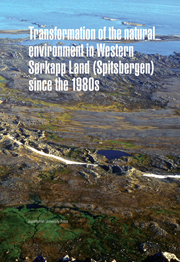Study area
Published online by Cambridge University Press: 05 September 2014
Summary
Why is Sørkapp Land, and specifically western Sørkapp Land, such an attractive area for scientific research?
The answer is: Due to its geographic location and natural environmental features that make it unique in this part of the Arctic.
Sørkapp Land is the southern peninsula of Spitsbergen, the largest island of the Svalbard Archipelago. The island's east-west width is 150–200 km in its northern part. The island narrows to the south in the shape of a wedge between the Barents Sea in the east and the Greenland Sea in the west (Fig. 1). Their waters differ in temperature, which affects local climate conditions. The eastern coast is affected by the cold East Spitsbergen Current, which flows from the Arctic interior towards the south. This results in extensive glaciation and the lack of continuous vegetation. On the other hand, the western coast is warmed from the south by the West Spitsbergen Current, the last branch of the Gulf Stream. This produces relatively little glaciation and allows for a continuous tundra. However, southern winds cause a narrow belt of the cold current's waters to separate the warm current from the coast. Moreover, the two coasts differ in terms of geological structure and relief. In the east, the mountains are built of non-resistant Cretaceous and Tertiary rocks that fall down directly into the sea or onto narrow coastal lowlands (less than 1 km wide) at some locations.
- Type
- Chapter
- Information
- Transformation of the Natural Environment in Western Sorkapp Land (Spitsbergen) since the 1980s , pp. 9 - 14Publisher: Jagiellonian University PressPrint publication year: 2011

